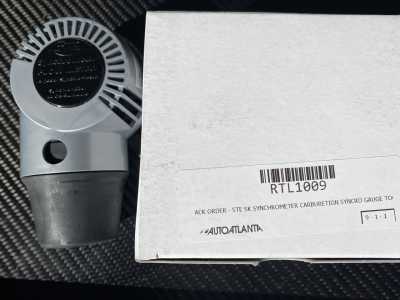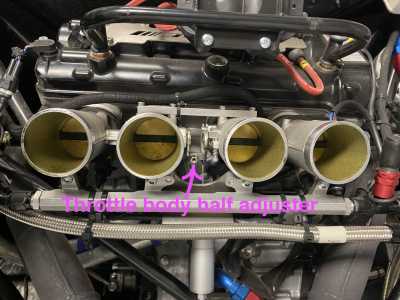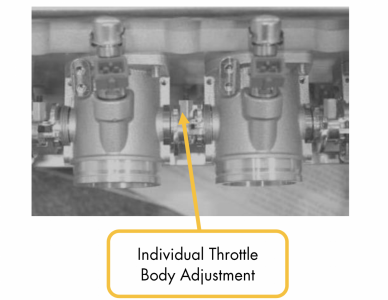
Notes on throttle body balancing, TPS, idle, and throttle adjustment
I am by no means an expert, but I recently purchased a syncrometer and balanced the throttle bodies on two SR3 XX 1500cc. Although the owners manual does not give a step by step procedure, I did find that the RPE GSX-R Engine Operation Manual describes the process well.
These are my notes:
The type of syncrometer which fits the throttle bodies is the SK type. I purchased a STE SK from www.autoatlanta.com. $42
I begin with a cold engine, not started.
1. remove the air box by cutting two zip ties on the front, and loosening four hose clamps on each of the throttle bodies. It is not necessary to disconnect the sensor. Set this aside so that you have access to the four throttle bodies.
2. Hook up your computer to the ECU and turn on the power switch. Start PTMon on your computer to see the TPS1 setting.
3. Loosen the idle adjustment screw until the TPS no longer reduces. This is fully closed throttle. Find the point where the TPS begins to increase and then adjust back to the fully closed position but not further.
4. Now set the TPS to 2.0 by loosening both screws and manually moving it one way or the other. Once you find 2.0, re-tighten the screws.
5. Now adjust your idle screw so that the TPS reads 4.0.
6. Start the car; it should be idling at or near 1600. Let the car warm up to 50C oil temp.
7. If necessary, adjust idle to 1600 rpm. (For both cars I did not need to make an idle adjustment.)
Next we adjust the throttle bodies. My manual says that there are individual throttle body adjusters, however my car only has a single adjustment between cylinders 2 and 3. Throttle bodies 1&2 and 3&4 are mechanically bound to each other, and so I only had to adjust each pair of throttle bodies to the other pair. The manual says otherwise, so I suspect that older cars have individual throttle body adjusters. In any case, either balance 1,2, and 4 to body 3, or the left half to the right half (newer cars?).
8. Place the syncrometer into body 3; this is the base. Now place the into throttle body 2 and adjust so that the air flow matches throttle body 3. Done. If you have individual throttle bodies, adjust all so they match 3.
My engine looks like the picture above. The owners manual shows this picture
Both of my cars required a very small adjustment to balance the throttle body halves, however the TPS was off on both. I think TPS 4.0 is not critical, however if you use the procedure above it makes it very easy to establish a base setting.
The last thing I do with the engine stopped but PTMon still running is manually move the throttle to the full throttle stop with my hand. Record that TPS number. In one of my cars the TPS is 106.5 at full throttle. Next, get into your car and press the throttle pedal to the floor. The TPS should read 106.5 (in my case) without stretching the throttle cable. If it is lower than the full throttle number, then remove enough slack from the throttle cable at the pedal until it matches the full throttle TPS value.
Let me know if you do any of this differently than I do.
@davidf - perfect write up and once again shows that we are on very similar 'learning curves'. I purchased the exact same syncrometer, and followed almost the exact same process.
If I followed your set-up notes correctly, then I think I took a slightly different route to the finla balancing of the throttle bodies. Like yours mine has cylinders 1&2 linked and cylinders 3&4 linked mechanically on the Jenvey throttles. So I simply took the average reading from 1&2, and adjusted to make 3&4 the same, so each 'half' of the engine was flowing the same amount at idle.




